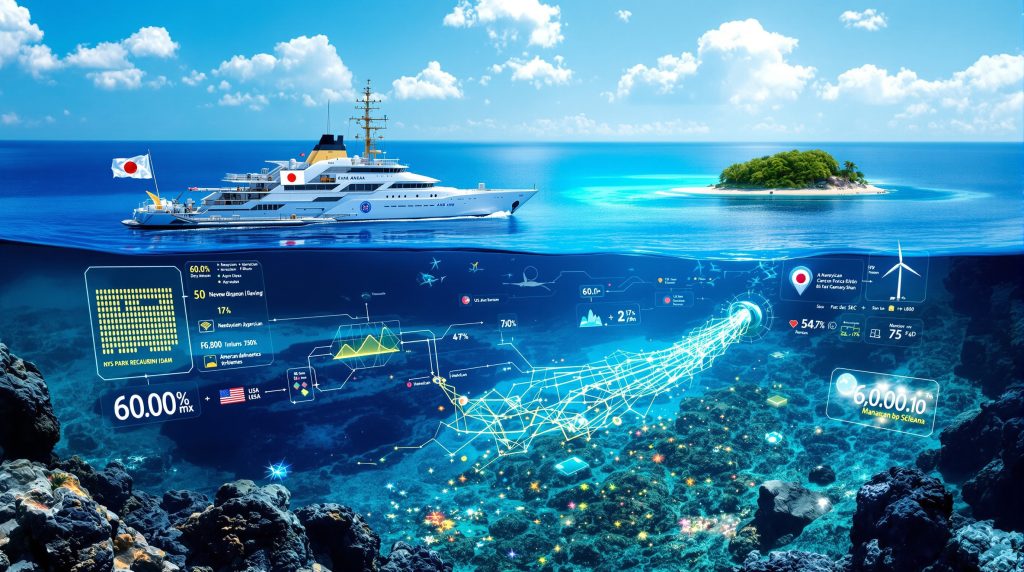Strategic Alliance Targets Critical Mineral Independence
The rare earth mining Japan US collaboration represents a transformative initiative designed to establish alternative supply chains for elements essential to modern technology and defense systems. This partnership focuses on extracting rare earth materials from deep-sea deposits located within Japan's exclusive economic zone around Minamitori Island, marking a significant shift in global critical mineral strategy.
Recent developments have accelerated this cooperation, with Japanese Prime Minister Sanae Takaichi confirming that rare earth mineral development was a central topic during discussions with US President Donald Trump. The two nations formalised their commitment through a framework agreement signed during Trump's recent visit to Tokyo, specifically targeting China's market dominance in materials used across industries from automotive manufacturing to military defence systems.
Breaking China's Stranglehold on Global Supply Chains
China currently maintains overwhelming control of the global rare earth sector, while the United States and Myanmar control approximately 12% and 8% respectively, according to Eurasia Group data. This concentration creates substantial vulnerabilities for technology-dependent nations, particularly given the strategic importance of these elements in critical applications.
Essential Applications Include:
- Advanced semiconductor manufacturing and electronics
- Electric vehicle battery systems and motor components
- Wind turbine generator technology
- Military defence equipment and weapons systems
- Renewable energy infrastructure development
The dominance of a single nation in controlling these supply chains presents both economic and national security risks. Price volatility, potential supply disruptions, and geopolitical leverage have prompted allied nations to seek diversification strategies. Furthermore, the rare earth mining Japan US partnership specifically addresses these vulnerabilities by developing extraction capabilities under democratic governance structures.
Historical precedents demonstrate how concentrated supply chains can become geopolitical tools. During trade disputes, export restrictions on critical materials have been used to exert economic pressure, highlighting the urgent need for alternative sources controlled by allied nations. The ongoing deep-sea mining controversy reflects these broader tensions over resource access.
Geographic and Geological Advantages of Minamitori Island
Minamitori Island sits approximately 1,900 kilometres southeast of Tokyo in the Pacific Ocean, placing it firmly within Japan's exclusive economic zone under international maritime law. This positioning eliminates complex international negotiations typically required for deep-sea extraction projects in international waters.
Geological surveys have confirmed the presence of rare earth-rich mud deposits at depths between 5,000 and 6,000 metres within this exclusive zone. According to a government-backed project executive, there exists an abundance of mud that potentially holds significant rare earth concentrations around the island.
Deposit Characteristics Present Unique Advantages:
- Naturally lower radioactive content compared to terrestrial deposits
- Reduced thorium and uranium contamination levels
- Simplified processing requirements through acid extraction methods
- Extensive deposit distribution across the seafloor
The deep-ocean environment offers additional benefits beyond geological composition. Unlike land-based mining operations, deep-sea extraction avoids complex environmental permitting processes associated with terrestrial ecosystems, land rights negotiations, and community displacement issues.
Japan's sovereign control over these waters provides legal mining authority under the United Nations Convention on the Law of the Sea (UNCLOS), streamlining regulatory approval processes and ensuring long-term operational security for the partnership.
Technical Implementation and Operational Timeline
Japan plans to commence feasibility testing for raising rare earth mud from 6,000-metre depths in January 2026, according to Prime Minister Takaichi's parliamentary statements. This initial phase will evaluate the technical viability of specialised equipment designed for extreme underwater conditions.
Project Development Timeline:
| Phase | Timeline | Objectives |
|---|---|---|
| Feasibility Testing | January 2026 | Equipment validation at 6,000m depth |
| System Refinement | 2026-2027 | Technology optimisation and scaling |
| Trial Operations | January 2027 | 350 metric tons daily mud recovery |
| Commercial Assessment | Post-2027 | Full-scale production evaluation |
If initial testing proves successful, the project aims to launch trial operations capable of recovering 350 metric tons of mud per day beginning January 2027. This operational target represents the demonstration phase before potential scaling to commercial production levels.
The technical challenges of operating at 6,000-metre depths involve extreme pressure conditions equivalent to approximately 600 atmospheres. Equipment must withstand corrosive saltwater environments while maintaining operational reliability in remote oceanic locations thousands of kilometres from nearest support facilities.
In addition, modern mine planning technology will be essential for optimising extraction processes at these unprecedented depths.
The specialised extraction system requires materials engineering advances to handle both the physical stresses of deep-ocean pressure and the chemical challenges of prolonged saltwater exposure.
Economic Implications and Investment Requirements
Deep-sea mining operations demand substantial capital investment for specialised vessels, extraction equipment, and processing facilities. The Japan-US collaboration enables cost-sharing arrangements and bilateral technology development, distributing financial risks across both nations' resources and expertise.
The 350 metric tons per day operational target during trial phases suggests significant scaling potential if technical and economic viability are demonstrated. This volume represents the initial proof-of-concept stage, with commercial production potentially requiring multiples of this daily extraction rate.
Economic Benefits Include:
- Reduced rare earth price volatility through supply diversification
- Enhanced supply chain resilience for both nations
- Technology transfer opportunities between Japanese and American companies
- Job creation across maritime industries and equipment manufacturing sectors
The partnership extends beyond extraction to encompass the entire rare earth value chain. Processing facilities, refining operations, and end-product manufacturing represent additional economic opportunities for both nations while reducing dependence on Chinese processing capabilities.
Investment requirements encompass vessel construction or modification, specialised pumping and lifting equipment, mud processing systems, and environmental monitoring technology. The remote location necessitates substantial logistical infrastructure development, including supply chain networks capable of supporting continuous operations.
National Security and Geopolitical Strategy
Prime Minister Takaichi emphasised that the Japanese government is advancing this national project as part of broader efforts to strengthen maritime and economic security. The initiative represents a fundamental shift toward allied cooperation on critical mineral independence.
Both nations view rare earth access as essential to maintaining technological superiority in defence applications. Modern military systems rely heavily on rare earth elements for guidance systems, communications equipment, radar technology, and advanced weaponry components.
Strategic Defence Applications:
- Missile guidance and targeting systems
- Military communications and encryption technology
- Radar and electronic warfare capabilities
- Advanced fighter jet and naval vessel components
However, the partnership aligns with broader US-Japan security cooperation frameworks while addressing vulnerabilities in defence supply chains. Military procurement policies increasingly emphasise domestic or allied-nation sourcing for critical components to reduce dependence on potentially adversarial suppliers.
Technology sharing agreements facilitate bilateral cooperation on research and development, manufacturing processes, and quality control standards. These arrangements strengthen both nations' industrial capabilities while fostering innovation in extraction and processing technologies. The Trump executive order on minerals further reinforces this strategic direction.
Technical Challenges and Operational Hurdles
Deep-sea mining at 6,000-metre depths presents unprecedented engineering challenges that must be overcome for project success. The extreme pressure environment requires specialised equipment capable of continuous operation under conditions that would destroy conventional machinery.
Critical Technical Obstacles:
- Extreme water pressure equivalent to 600 atmospheres
- Corrosive saltwater environment affecting all equipment surfaces
- Remote location logistics requiring autonomous or semi-autonomous systems
- Equipment reliability requirements with limited maintenance accessibility
The corrosive nature of deep ocean saltwater necessitates advanced materials engineering for all components exposed to the marine environment. Conventional metals and alloys cannot withstand prolonged exposure, requiring specialised coatings, exotic materials, or frequent replacement schedules.
Remote location operations compound these challenges, as equipment failures cannot be quickly addressed through conventional maintenance procedures. Systems must incorporate redundancy, self-diagnostic capabilities, and modular replacement designs to maintain operational continuity.
Environmental monitoring requirements add complexity to operational systems. Deep-sea ecosystems remain poorly understood, necessitating comprehensive baseline studies and continuous monitoring during extraction activities to assess environmental impact.
Global Context and Alternative Development Efforts
The rare earth mining Japan US partnership occurs within a broader global movement toward rare earth supply diversification. Multiple nations and regions are developing alternative sources to reduce dependence on Chinese production capabilities.
Major Alternative Initiatives Include:
- Australia's Mount Weld operations through Lynas Rare Earths
- Canadian rare earth development projects in various provinces
- European Union critical materials strategy and domestic sourcing initiatives
- US domestic mining expansion programmes in several western states
Australia's Lynas Rare Earths operates one of the world's most significant rare earth sources outside China through its Mount Weld facility in Western Australia. This operation provides a model for non-Chinese rare earth production while highlighting both opportunities and challenges in alternative sourcing.
European Union initiatives focus on reducing import dependence through domestic extraction, recycling programmes, and strategic partnerships with democratic nations. The EU's critical materials strategy emphasises supply chain resilience across multiple critical minerals beyond rare earths.
Comparative Advantages of Deep-Sea Extraction:
- Avoids land use conflicts and community displacement issues
- Reduced processing complexity due to lower radioactive content
- Access to previously untapped reserves under sovereign control
- Minimal environmental permitting complications compared to terrestrial mining
Consequently, the critical minerals energy transition requires diversified supply sources to ensure sustainable progress.
Performance Metrics and Success Indicators
Project success will be measured across multiple dimensions, including technical performance, economic viability, and strategic objectives achievement. The January 2026 feasibility testing represents the first major milestone for technical validation.
Key Performance Indicators:
Technical Milestones
- Daily extraction volume achievement of 350 metric tons during trial phase
- Processing efficiency rates for rare earth element recovery from mud
- Equipment operational reliability and uptime percentages
- Environmental impact minimisation and compliance with regulatory standards
Strategic Objectives
- Supply chain diversification percentage away from Chinese sources
- Cost competitiveness with existing terrestrial and Chinese production
- Technology transfer effectiveness between Japanese and American entities
- Long-term resource sustainability and extraction capacity scaling
The 350 metric tons daily target during trial operations provides a measurable benchmark for system performance. Successful achievement of this volume demonstrates technical feasibility while providing data for commercial-scale operations planning.
Economic competitiveness requires achieving extraction and processing costs comparable to or lower than existing sources while factoring in strategic value premiums for secure supply chains. Price comparison must include total lifecycle costs, including transportation, processing, and environmental compliance.
Long-Term Market Impact and Future Implications
Successful implementation of the rare earth mining Japan US partnership could fundamentally alter global rare earth market dynamics by introducing a major new supply source controlled by democratic allies rather than a single authoritarian regime.
Current market structure reflects heavy concentration risk, with China controlling the vast majority of global production and processing capacity. The introduction of significant alternative production capacity would reduce this concentration while providing price stability through competitive supply sources.
Market Structure Evolution Potential:
- Reduced price volatility through supply diversification
- Enhanced negotiating power for consuming nations
- Technology innovation acceleration in extraction and processing methods
- Supply chain resilience improvement for critical industries
The partnership may catalyse additional deep-sea mining initiatives throughout the Pacific, establishing a new paradigm for critical mineral security among allied nations. Success near Minamitori could lead to exploration of similar deposits in other exclusive economic zones.
Technology spillover effects from deep-sea rare earth extraction could benefit other critical mineral recovery projects. Equipment, techniques, and operational procedures developed for this partnership may find application in copper, cobalt, and other strategic mineral extraction from oceanic sources.
Future Expansion Possibilities
- Additional deep-sea sites within Japanese territorial waters
- Technology transfer to other allied nations with suitable deposits
- Integration with existing Pacific region mining operations
- Development of regional processing and refining capabilities
The strategic implications extend beyond immediate supply chain benefits to encompass broader geopolitical realignment in critical mineral markets. Democratic nations' control over alternative supplies reduces the potential for resource-based economic coercion while strengthening alliance cooperation frameworks.
Environmental considerations will influence long-term sustainability and public acceptance of deep-sea extraction operations. The naturally lower radioactive content of seafloor deposits compared to terrestrial sources may provide environmental advantages that support expanded operations.
Regulatory Framework and Compliance Considerations
The project operates within Japan's exclusive economic zone, providing regulatory clarity under established maritime law frameworks. This positioning eliminates the complex international seabed authority permitting processes required for mining in international waters.
Environmental impact assessments will be required under Japanese domestic law and international maritime conventions. Baseline ecosystem studies around Minamitori Island must establish current conditions before extraction activities commence.
The framework agreement between Japan and the United States establishes bilateral cooperation protocols while respecting each nation's sovereignty over domestic regulatory processes. Technology sharing arrangements require compliance with export control regulations and intellectual property protections.
International precedents for deep-sea mining remain limited, making the Minamitori project a potential model for future operations. Regulatory frameworks developed for this partnership may influence international standards for similar projects worldwide.
Disclaimer: This analysis includes forward-looking statements about potential project outcomes based on publicly available information. Actual results may differ materially from projections due to technical, economic, environmental, or regulatory factors. Investment decisions should not be based solely on speculative project assessments.
Looking to Capitalise on Critical Mineral Market Developments?
Discovery Alert's proprietary Discovery IQ model delivers real-time notifications on significant ASX mineral discoveries, including critical minerals and rare earth opportunities that could benefit from changing global supply dynamics. With historic discoveries like those by De Grey Mining and WA1 Resources demonstrating the potential for substantial returns, subscribers gain immediate access to actionable investment insights before the broader market. Start your 30-day free trial at Discovery Alert today to position yourself ahead of emerging opportunities in the evolving critical minerals sector.




